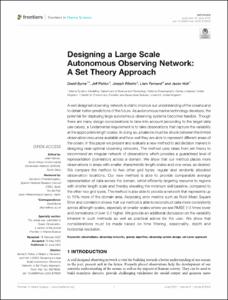| dc.contributor.author | Byrne, David | |
| dc.contributor.author | Polton, Jeff | |
| dc.contributor.author | Ribeiro, Joseph | |
| dc.contributor.author | Fernand, Liam | |
| dc.contributor.author | Holt, Jason | |
| dc.date.accessioned | 2022-11-08T10:56:13Z | |
| dc.date.available | 2022-11-08T10:56:13Z | |
| dc.date.issued | 2022 | |
| dc.identifier.citation | Byrne, D., Polton, J. Ribeiro, J., Fernand, L. and Holt, J ,(2022) Designing a Large Scale Autonomous Observing
Network: A Set Theory Approach. Front.iers in Marine Science, 9:879003, 15pp. DOI: 10.3389/fmars.2022.879003 | en_US |
| dc.identifier.uri | https://repository.oceanbestpractices.org/handle/11329/2083 | |
| dc.description.abstract | A well designed observing network is vital to improve our understanding of the oceans and
to obtain better predictions of the future. As autonomous marine technology develops, the
potential for deploying large autonomous observing systems becomes feasible. Though
there are many design considerations to take into account (according to the target data
use cases), a fundamental requirement is to take observations that capture the variability
at the appropriate length scales. In doing so, a balance must be struck between the limited
observation resources available and how well they are able to represent different areas of
the ocean. In this paper we present and evaluate a new method to aid decision makers in
designing near-optimal observing networks. The method uses ideas from set theory to
recommend an irregular network of observations which provides a guaranteed level of
representation (correlation) across a domain. We show that our method places more
observations in areas with smaller characteristic length scales and vice versa, as desired.
We compare the method to two other grid types: regular and randomly allocated
observation locations. Our new method is able to provide comparable average
representation of data across the domain, whilst efficiently targeting resource to regions
with shorter length scale and thereby elevating the minimum skill baseline, compared to
the other two grid types. The method is also able to provide a network that represents up
to 15% more of the domain area. Assessing error metrics such as Root Mean Square
Error and correlation shows that our method is able to reconstruct data more consistently
across all length scales, especially at smaller scales where we see RMSE 2-3 times lower
and correlations of over 0.2 higher. We provide an additional discussion on the variability
inherent in such methods as well as practical advice for the user. We show that
considerations must be made based on time filtering, seasonality, depth and
horizontal resolution. | en_US |
| dc.language.iso | en | en_US |
| dc.rights | Attribution 4.0 International | * |
| dc.rights.uri | http://creativecommons.org/licenses/by/4.0/ | * |
| dc.subject.other | Observing networks | en_US |
| dc.subject.other | Greedy algorithm | en_US |
| dc.subject.other | Observing system design | en_US |
| dc.subject.other | Set cover approach | en_US |
| dc.title | Designing a Large Scale Autonomous Observing Network: A Set Theory Approach. | en_US |
| dc.type | Journal Contribution | en_US |
| dc.description.refereed | Refereed | en_US |
| dc.format.pagerange | 15pp. | en_US |
| dc.identifier.doi | https://doi.org/10.3389/fmars.2022.879003 | |
| dc.subject.parameterDiscipline | Physical oceanography | en_US |
| dc.subject.dmProcesses | Data archival/stewardship/curation | en_US |
| dc.subject.dmProcesses | Data acquisition | en_US |
| dc.bibliographicCitation.title | Frontiers in Marine Science | en_US |
| dc.bibliographicCitation.volume | 9 | en_US |
| dc.bibliographicCitation.issue | Article 879003 | en_US |
| dc.description.sdg | 14.a | en_US |
| dc.description.maturitylevel | Concept | en_US |
| dc.description.frontiers | 2022-06-22 | |
| dc.description.adoption | Novel (no adoption outside originators) | en_US |
| dc.description.methodologyType | Reports with methodological relevance | en_US |
| obps.contact.contactname | David Byrne | |
| obps.contact.contactemail | dbyrne@noc.ac.uk | |
| obps.resourceurl.publisher | https://www.frontiersin.org/articles/10.3389/fmars.2022.879003/ | |
 Repository of community practices in Ocean Research, Applications and Data/Information Management
Repository of community practices in Ocean Research, Applications and Data/Information Management

